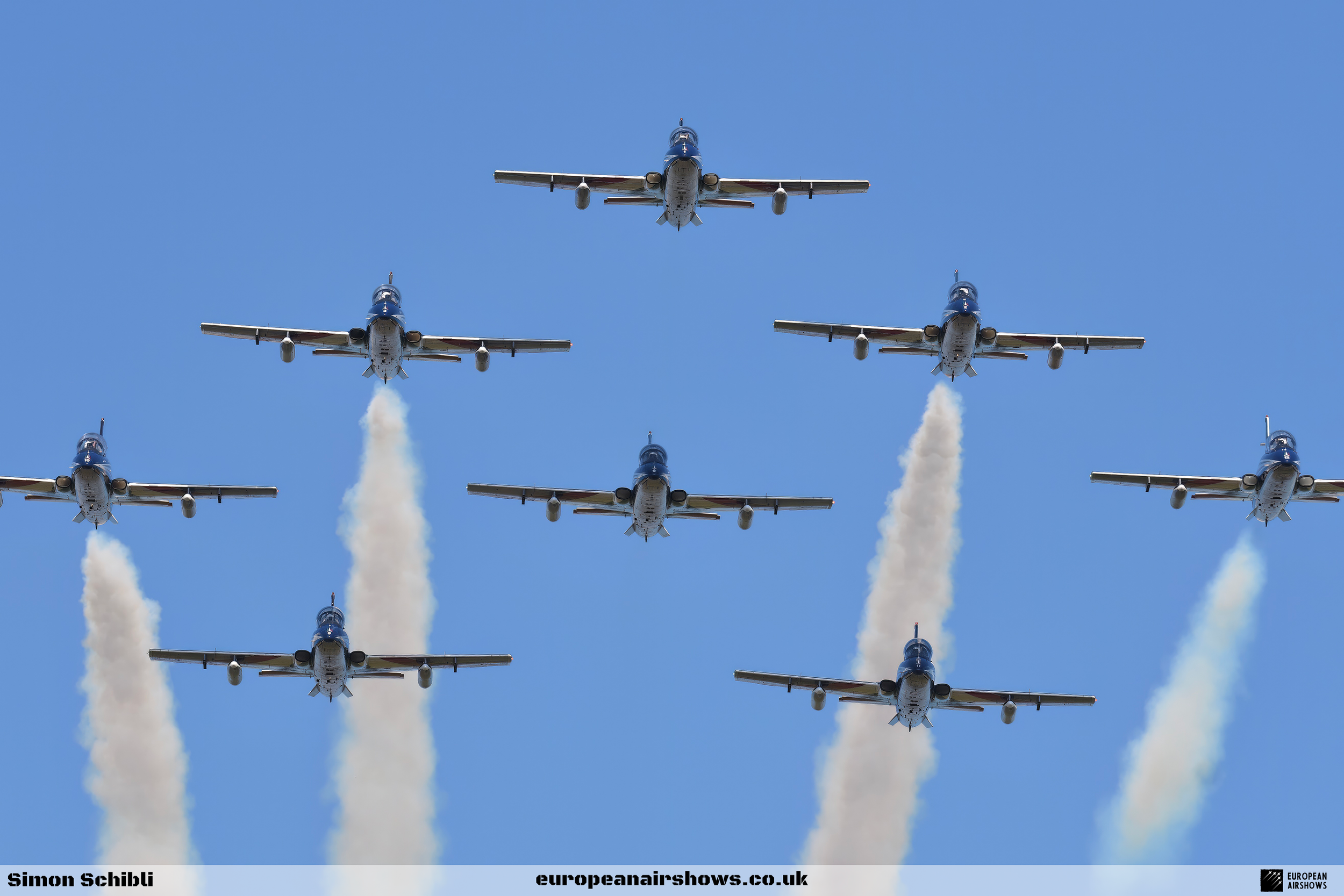
August 12 / Aermacchi MB-339 first flight
First Flight 12 August 1976
Aermacchi MB-339
The Aermacchi MB-339 is a remarkable aircraft with a rich history that spans several decades. Its development was initiated in the early 1970s by the Italian aerospace company Aermacchi, now part of Leonardo S.p.A. The MB-339 was conceived as a successor to the MB-326, a highly successful jet trainer also developed by Aermacchi. The goal was to create a more modern and capable aircraft that could meet the evolving needs of both military training and light attack roles.
The MB-339 first took to the skies on August 12, 1976, with its maiden flight demonstrating its promising capabilities. Designed by Ermanno Bazzocchi, the aircraft featured a low-wing monoplane design with a straight wing configuration, which was somewhat unconventional at the time. This design choice was intended to provide excellent handling characteristics and stability, making it an ideal platform for training new pilots.
One of the defining features of the MB-339 is its tandem seating arrangement, which places the instructor and student pilot in a line, one behind the other. This configuration allows for excellent visibility for both occupants and facilitates effective training. The aircraft is powered by a single Rolls-Royce Viper turbojet engine, which provides a good balance of performance and reliability.
The MB-339A, the initial production version, entered service with the Italian Air Force in 1979, replacing the older MB-326s. It quickly gained a reputation for its excellent flight characteristics and versatility. The aircraft was not only used for basic and advanced pilot training but also for weapons training and light attack missions. Its design allowed for the installation of various weapon systems, including machine guns, rockets, and bombs, making it a flexible platform for a variety of military operations.
In addition to its service with the Italian Air Force, the MB-339 found success on the international market. Several countries, including Argentina, Malaysia, New Zealand, and the United Arab Emirates, adopted the aircraft for their training and light attack needs. The MB-339’s adaptability to different environments and mission profiles contributed to its widespread use.
One of the most iconic roles of the MB-339 is its use by the Italian Air Force’s aerobatic display team, the Frecce Tricolori. The team, known for its precision flying and complex manoeuvres, has been flying the MB-339 since 1982. The aircraft’s agility and performance make it an ideal choice for aerobatic displays, and it has become a symbol of Italian aviation excellence.
Over the years, the MB-339 has undergone several upgrades and modifications to keep it relevant in a changing aviation landscape. The MB-339CD, for example, introduced digital avionics and improved systems to enhance its training capabilities. The aircraft’s versatility has also led to the development of specialized variants, such as the MB-339K for carrier operations and the MB-339FD for forward air control missions.
Despite its age, the MB-339 continues to serve in various air forces around the world. Its enduring popularity can be attributed to its robust design, ease of maintenance, and adaptability to different roles. The aircraft has proven to be a reliable workhorse for pilot training and light attack missions, earning the respect of pilots and maintenance crews alike.
The Aermacchi MB-339 is a testament to the ingenuity and engineering prowess of its designers. Its successful blend of performance, versatility, and reliability has ensured its place in aviation history. Whether training the next generation of pilots or performing in breathtaking aerobatic displays, the MB-339 remains a vital and cherished aircraft in the global aviation community.
MB339 Facts
Single-Seat Ground Attack Variant: The MB-339K is indeed a single-seat version designed for ground attack and close air support missions. This variant was developed with enhanced combat capabilities, featuring reinforced structures and additional hardpoints for carrying a variety of ordnance.
Advanced Flight Training: The MB-339 has been extensively used for advanced flight training, including weapons delivery and tactical manoeuvres. Its design allows it to simulate the performance and handling characteristics of frontline combat aircraft, making it an invaluable tool for preparing pilots for operational duties.
Integrated Weapons Systems: The MB-339 can be equipped with a wide range of weapons systems, including machine guns, rockets, and bombs. It also has provisions for carrying air-to-air missiles, making it a versatile platform for both air-to-ground and air-to-air training missions.
International Collaborations: The MB-339 has been part of various international collaborations and joint training exercises. This has allowed pilots from different countries to train together and share best practices, enhancing interoperability among allied air forces.
Aerobatic Excellence: The MB-339’s role with the Frecce Tricolori, the Italian Air Force’s aerobatic display team, is well-known. However, its design features, such as its precise control responsiveness and robust airframe, were specifically chosen to facilitate complex aerobatic manoeuvres, making it a standout in airshows worldwide.
Long Service Life: Despite being introduced in the late 1970s, the MB-339 remains in service today, thanks to continuous upgrades and its adaptable design. Its longevity is a testament to the quality of its engineering and the effectiveness of its design.
Export Success: The MB-339 has been exported to numerous countries around the world. Each customer has often tailored the aircraft to meet specific national requirements, showcasing its flexibility and broad appeal.
Training Versatility: The aircraft’s ability to switch between different training roles, from basic pilot instruction to advanced combat training, without significant modifications, makes it a highly cost-effective solution for air forces.
Survivability Features: The MB-339 is equipped with survivability features such as self-sealing fuel tanks and redundancy in critical systems. These features enhance the safety of the aircraft in combat situations, providing additional protection for the pilot.
Technological Evolution: Over the years, the MB-339 has incorporated various technological advancements, such as improved avionics, navigation systems, and weapon delivery systems. These upgrades have kept the aircraft relevant in an era of rapid technological change in military aviation.

















